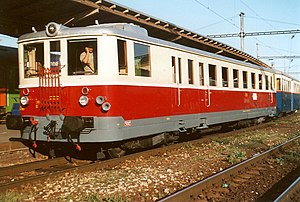User:Lukas4202/sandbox
| ČSD Class M 262.0, M 262.1 | |
|---|---|
 M 262.0 railcar of the first series in Bratislava | |
| Stock type | Diesel railcar |
| In service | 1949-2011 |
| Manufacturer | ČKD Praha, Královopolská strojírna Brno, Vagónka Tatra Studénka |
| Constructed | 1949-1960 |
| Refurbished | 1981-1991 |
| Number built | 250 |
| Capacity | 80 |
| Operators | |
| Specifications | |
| Car length |
|
| Width | 3,080 millimetres (10.10 ft) |
| Height | 3,745 millimetres (12.287 ft) |
| Wheelbase | 2´ Bo´ |
| Maximum speed | 90 kilometres per hour (56 mph) |
| Weight |
|
| Prime mover(s) | four-stroke diesel engine |
| Engine type |
|
| Cylinder count |
|
| Track gauge | 1,435 mm (4 ft 8+1⁄2 in) |
The ČSD Class M 262.0, later the Class 830 railcars were built after the World War II for the Czechoslovak State Railways to meet their demand for a fast, modern railcar for mainline use. During the 1980s, some of them had their diesel engine replaced with a more modern one, changing their designation to Class M 262.1, later the Class 831. The last railcars were taken out of regular service in 2011, putting them among the longest-operated railcars in Europe.
History
[edit]The Czechoslovak State Railways had a long tradition of railcar operation before the World War II. The vehicles ranged from small railbuses to diesel-electric mainline railcars, such as M 274.0, and high-speed M 290.0 railcar. After the war, the Czechoslovak railways demanded a new, modern type of a diesel-electric mainline railcar. For the branch lines, the M 131.1 diesel-mechanical vehicles were successfully produced in large numbers since 1948.
The cars were manufactured in three different versions. The first series, number 001 - 052, did not have an exterior door into the driver's cab and also lacked red taillights, which were added only later during repair works. The air horns were placed under the front windows. The second series had the horns repositioned to the roof. The third series is visually significantly different from the first and second one. The roof is higher and the gangway on the front of the car is covered by metal plates. The traction circuits and control elements are slightly different.
The Class M 262.0 was initially not provided with dedicated trailing cars. Various older lightweight cars were used. During the 1960s, a large series of the Balm trailing cars was produced. These new cars were then mostly used with the M 262.0 until the end of their deployment.
Over the years, the railcars proved their durability and popularity with train crews and passengers, who appreciated their smooth ride and comfortable interior. The most problematic part of the vehicle was its diesel engine. The diesels were maintenance-intensive, unreliable and fuel-thirsty, spare parts were scarce. In the 1980s, 41 of the railcars were equipped with a new ČKD six-cylinder turbocharged engine, originally designed for river towboats. The reliability and fuel consumption was much improved. Originally, only cars of the third series were to be re-engined, but in the end, six railcars of the first two series were rebuilt as well. The rebuilt cars were present only in Czech lands.
Although the cars proved to be reliable, they became severely outdated over the decades of their operation. Since the 1970s, ČSD planned their replacement with more modern designs. Two prototypes of the M 475.0 railcars were successfully tested, but their series production never started for various political reasons. The fairly modern diesel-hydraulic 842 and diesel-electric 843 classes were built for the ČD during the 1990s, but their number was not sufficient to replace all the older railcars. ŽSR did not buy any new railcars at all for many years and relied on their aging fleet.
ŽSR retired their entire fleet of old four-axle railcars (830, 850 and 851) in 2003 despite having no new large railcars to replace them. ČD continued using the 830 railcars until 2007, when the 830.159 was retired as the last of its type. The 831 railcars operated on the mountainous lines around Šumperk and Klatovy until 2011. Various cars of both classes have been preserved in operational condition as museum units, both state-owned and private.
The cars had a reputation for being prone to fires. The fire usually started by a fuel or oil leak coming in contact with hot exhaust pipes. Once the fire started, it would usually consume the entire vehicle in few minutes, as the body contained lots of wood and other flammable materials. As much as one third of the entire fleet has been destroyed by fire, including some museum cars in recent years. Luckily, there was usually enough time to evacuate the vehicle before the fire fully developed.
Design
[edit]The M 262.0 railcar incorporated some new design elements. The bogies were of an entirely new type, which enabled the floor of the car to be positioned lower than in older classes. The diesel engine and the main generator are placed in the bogie, so the vibration of the engine is not transferred to the body of the car. The axles of this bogie are unpowered. The two traction motors are placed in the other bogie. The cooling fans, the compressor and the auxiliary starter-generator are placed under the floor and powered from the diesel via a long shaft with universal joints. Another difference from the older designs is that the railcar does not have a separate engine room. The diesel engine is placed in the roomy driver's cab under a large cover.

